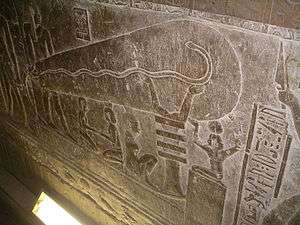Dendera light

The Dendera light is a motif carved as a set of stone reliefs in the Hathor temple at Dendera in Egypt, which superficially resemble modern electric lighting devices. A fringe hypothesis suggests that the Dendera light depicts advanced electrical technology possessed by the ancient Egyptians; however, mainstream Egyptologists view the carvings as representing instead a typical set of symbolic images from Egyptian mythology. These depict a djed pillar and a lotus flower spawning a snake inside it, symbols of stability and fertility, respectively.
Mainstream interpretation
The view of Egyptologists is that the relief is a mythological depiction of a djed pillar and a lotus flower (Nymphaea caerulea), spawning a snake within, representing aspects of Egyptian mythology.[1][2] The djed pillar is a symbol of stability which is also interpreted as the backbone of the god Osiris. In the carvings the four horizontal lines forming the capital of the djed are supplemented by human arms stretching out, as if the djed were a backbone. The arms hold up the snake within the lotus flower. The snakes coming from the lotus symbolize fertility, linked to the annual Nile flood.[2]
Fringe interpretation
In contrast to the mainstream interpretation, a fringe hypothesis proposes that the reliefs depict Ancient Egyptian electrical technology, based on comparison to similar modern devices (such as Geissler tubes, Crookes tubes, and arc lamps).[3][4] J. N. Lockyer's passing reference to a colleague's humorous suggestion that electric lamps would explain the absence of lampblack deposits in the tombs has sometimes been forwarded as an argument supporting this particular interpretation (another argument being made is the use of a system of reflective mirrors).[5] Proponents of this interpretation have also used a text referring to "high poles covered with copper plates" to argue this[6] but Bolko Stern has written in detail explaining why the copper covered tops of poles (which were lower than the associated pylons) do not relate to electricity or lightning, pointing out that no evidence of anything used to manipulate electricity had been found in Egypt and that this was a magical and not a technical installation.[7]
See also
References
- ↑ Wolfgang Waitkus, Die Texte in den unteren Krypten des Hathortempels von Dendera: ihre Aussagen zur Funktion und Bedeutung dieser Räume, Mainz 1997 ISBN 3-8053-2322-0 (tr., The texts in the lower crypts of the Hathor temples of Dendera: their statements for the function and meaning of these areas)
- 1 2 "Dendera Temple Crypt". iafrica.com.
- ↑ Childress, D. H. (2000). Technology of the gods: the incredible sciences of the ancients. Kempton, Ill: Adventures Unlimited Press. ISBN 0932813739
- ↑ Electricity in ancient times. WUFOC and NÄRKONTAKT.
- ↑ Lockyer, J. Norman (1998) [1894]. The Dawn of Astronomy. Kessinger Publishing. pp. 180–1. ISBN 1564591123.
- ↑ Bruno Kolbe, Francis ed Legge, Joseph Skellon, tr., "An Introduction to Electricity". Kegan Paul, Trench, Trübner, 1908. 429 pages. Page 391. (cf., "[...] high poles covered with copper plates and with gilded tops were erected 'to break the stones coming from on high'. J. Dümichen, Baugeschichte des Dendera-Tempels, Strassburg, 1877")
- ↑ Stern, Bolko (1998) [1896]. Ägyptische Kulturgeschichte. Reprint-Verlag-Leipzig. pp. 106–108. ISBN 978-3826219085.
External links
| Wikimedia Commons has media related to Dendera light. |
- The Dendera Reliefs, Catchpenny Mysteries.
- Frank Dörnenburg, Electric lights in Egypt?. 2004. (ed. An analysis of how the Egyptians didn't have electricity).